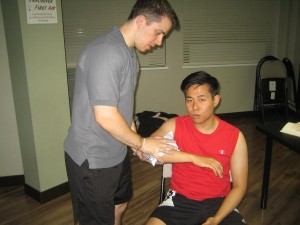Olecranon or elbow bursitis involves inflammation of the bursa in between the elbow and the skin. The bursa is a lubricating sac that helps prevent extensive rubbing of the bone and skin while engaging in physical activities.
Elbow bursitis develops around the elbow joint during constant movements in various sports such as tennis. If the individual experiences joint pain that lasts for more than 2 weeks or there is severe swelling, intense pain or fever, a doctor should be consulted for further assessment.
Application of ice

In cases in which elbow bursitis is not due to an infection, the elbow must be elevated and apply an ice pack or pack of frozen vegetables at the tip of the elbow. The application must last for about 20 minutes and then remove for 20 minutes. The cycle must be repeated as often as possible for the initial 2 days. Instruct the individual to apply an ice pack on the elbow in case of flare-ups in the future.
Medications
An individual with elbow bursitis can be given oral medications. The doctor might recommend non-steroidal anti-inflammatory drugs (NSAIDs) such as naproxen or ibuprofen. It is vital to carefully follow the instructions regarding the dosage.
These medications can minimize the swelling in the bursa in order to relieve the elbow pain. As long as these medications are taken correctly, any potential complications such as stomach irritation or liver or kidney damage can be avoided. The individual should inform the doctor if he/she is using these medications. Additionally, consult the doctor if these medications can be continued if new medications are prescribed.
Cortisone injections
In severe cases, the doctor might recommend the aspiration of the fluid and injecting corticosteroid into the bursa. The steroid might minimize the swelling more effectively than the oral medications since it is administered directly into the bursa. In addition, steroids have a potent anti-inflammatory action than the NSAIDs. Just remember though that these injections will not always effectively manage the symptoms and this is a risk for introducing infection into the area.
Surgical intervention
In case the bursa is infected and could not be managed with medications, the doctor might recommend surgery in order to remove the bursa. In some cases, a non-infected bursa might still require removal if it does not respond to conservative treatments.
The potential risks for surgery are somewhat minimal since the procedure does not involve any disruption on the ligaments, muscles or bones. Nevertheless, since it is a surgical procedure, there is also the risk for infection, bleeding or structural damage. With this in mind, the individual should carefully discuss this option with the doctor first.
